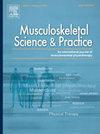Do cervical spine angles differ in patients with hypermobility who suffer from neck pain?
IF 2.2
3区 医学
Q1 REHABILITATION
引用次数: 0
Abstract
Backround
There has been a noted increase in the number of patients experiencing chronic neck pain who exhibit diminished cervical lordosis upon radiographic examinations. While neck overuse contributes to this trend, early identification and treatment of predisposing factors such as hypermobility can potentially mitigate this increase.
Objective
This study aims to explore the impact of hypermobility on cervical angles, neck disability and health quality in patients experiencing neck pain.
Participants
Participants aged between 20 and 40 years with neck pain persisting for more than three months were recruited. Patients were stratified based on hypermobility status. Lateral cervical radiographs were obtained to measure various cervical angles. Disability associated with neck pain and health-related quality of life were assessed. The influence of hypermobility on these parameters in neck pain patients was examined.
Results
Hypermobile patients with neck pain exhibited significantly lower C0-2 Cobb angle (Cohen's d: 0.60), decreased C2-7 angle measured by Jackson physiological stress lines (Cohen's d: 0.42), increased cranial tilt (Cohen's d: 0.561), and greater C2-7 sagittal vertical axis (Cohen's d: 0.36) compared to non-hypermobile patients with neck pain. No significant differences were observed in neck disability or health-related quality of life between hypermobile and non-hypermobile neck pain patients. There was a weak association between a more physiologic cervical lordosis and a lower disability scores among hypermobile patients with neck pain.
Conclusion
Hypermobility may lead to alterations in cervical spinal angles in young adults with neck pain. Early detection and intervention could help maintain cervical angles and prevent lordosis reduction.
活动度高的颈部疼痛患者的颈椎角度不同吗?
背景:在放射检查中表现出颈椎前凸减轻的慢性颈部疼痛患者的数量明显增加。虽然颈部过度使用导致了这一趋势,但早期识别和治疗过度活动等易感因素可能会减轻这种增加。目的探讨活动过度对颈痛患者颈椎角度、颈部功能障碍和健康质量的影响。参与者年龄在20到40岁之间,颈部疼痛持续超过3个月。患者根据活动过度状态进行分层。颈椎侧位x线片测量不同的颈椎角度。评估与颈部疼痛和健康相关的生活质量相关的残疾。研究了颈部疼痛患者活动过度对这些参数的影响。结果与非运动过度的颈痛患者相比,运动过度的颈痛患者的c2 -2 Cobb角明显降低(Cohen’s d: 0.60), Jackson生理应力线测量的C2-7角明显降低(Cohen’s d: 0.42),颅骨倾斜增加(Cohen’s d: 0.561), C2-7矢状垂直轴明显增大(Cohen’s d: 0.36)。运动过度和非运动过度的颈部疼痛患者在颈部残疾或与健康相关的生活质量方面未观察到显著差异。活动量大且颈部疼痛的患者的生理性颈椎前凸与较低的残疾评分之间存在弱关联。结论运动过度可导致青年颈痛患者颈椎角度的改变。早期发现和干预有助于保持颈椎角度,防止前凸复位。
本文章由计算机程序翻译,如有差异,请以英文原文为准。
求助全文
约1分钟内获得全文
求助全文
来源期刊

Musculoskeletal Science and Practice
Health Professions-Physical Therapy, Sports Therapy and Rehabilitation
CiteScore
4.10
自引率
8.70%
发文量
152
审稿时长
48 days
期刊介绍:
Musculoskeletal Science & Practice, international journal of musculoskeletal physiotherapy, is a peer-reviewed international journal (previously Manual Therapy), publishing high quality original research, review and Masterclass articles that contribute to improving the clinical understanding of appropriate care processes for musculoskeletal disorders. The journal publishes articles that influence or add to the body of evidence on diagnostic and therapeutic processes, patient centered care, guidelines for musculoskeletal therapeutics and theoretical models that support developments in assessment, diagnosis, clinical reasoning and interventions.
 求助内容:
求助内容: 应助结果提醒方式:
应助结果提醒方式:


